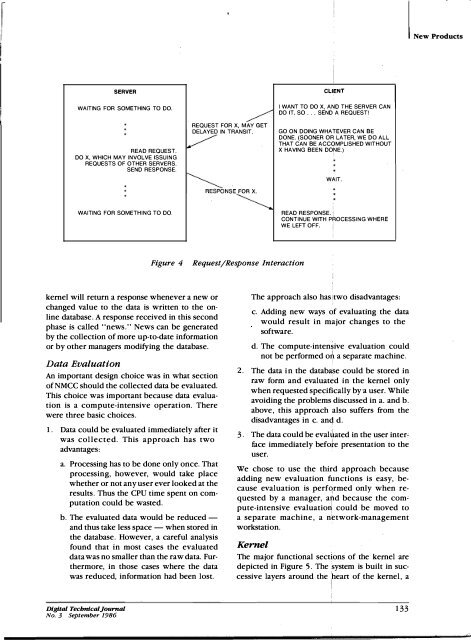DTJ Number 3 September 1987 - Digital Technical Journals
DTJ Number 3 September 1987 - Digital Technical Journals
DTJ Number 3 September 1987 - Digital Technical Journals
Create successful ePaper yourself
Turn your PDF publications into a flip-book with our unique Google optimized e-Paper software.
IiNew ProductsSERVERWAITING FOR SOMETHING TO DO.READ REQUEST.DO X, WHICH MAY INVOLVE ISSUINGREQUESTS OF OTHER SERVERS.SEND RESPONSE.REQUEST FOR X, M 7 IN TRANSIT.NSECLIENTI WANT TO DO X, AND THE SERVER CANDO IT, SO . .. SEND A REQUEST!GO ON DOING WHATEVER CAN BEDONE. (SOONER OR LATER, WE DO ALLTHAT CAN BE ACCOMPLISHED WITHOUTX HAVING BEEN DOE.)WAIT.WAITING FOR SOMETHING TO DO.READ RESPONSE. jCONTINUE WITH PROCESSING 'WHEREWE LEFT OFF.Figure 4RequestjResponse Interactionkernel will return a response whenever a new orchanged value to the data is written to the onlinedatabase. A response received in this secondphase is called "news." News can be generatedby the collection of more up-to-date informationor by other managers modifying the database.Data EvaluationAn important design choice was in what sectionof NMCC should the collected data be evaluated.This choice was imponant because data evaluationis a compute-intensive operation. Therewere three basic choices.1. Data could be evaluated immediately after itwas collected. This approach has twoadvantages:a. Processing has to be done only once. Thatprocessing, however, would take placewhether or not any user ever looked at theresults. Thus the CPU time spent on computationcould be wasted.b. The evaluated data would be reduced -and thus take less space - when stored inthe database. However, a careful analysisfound that in most cases the evaluateddata was no smaller than the raw data. Furthermore,in those cases where the datawas reduced, information had been lost.2.i .The approach also has I two disadvantages:Ic. Adding new ways of evaluating the datawould result in major changes to thesoftware.d. The compute-intenive evaluation couldnot be performed ort a separate machine.The data in the databe could be stored inraw form and evaluated in the kernel onlywhen requested specifically by a user. Whileavoiding the problems discussed in a. and b.above, this approach also suffers from thedisadvantages in c. anq d.3. The data could be evalated in the user inter'face immediately befote presentation to theuser.We chose to use the third approach becauseadding new evaluation functions is easy, becauseevaluation is perfqrmed only when requestedby a manager, and because the com:pute-intensive evaluatio could be moved toa separate machine, a network-managementworkstation.KernelThe major functional sections of the kernel aredepicted in Figure 5. The system is built in successivelayers around the bean of the kernel, a!<strong>Digital</strong> TecbntcalJournalNo. 3 <strong>September</strong> 1986133









